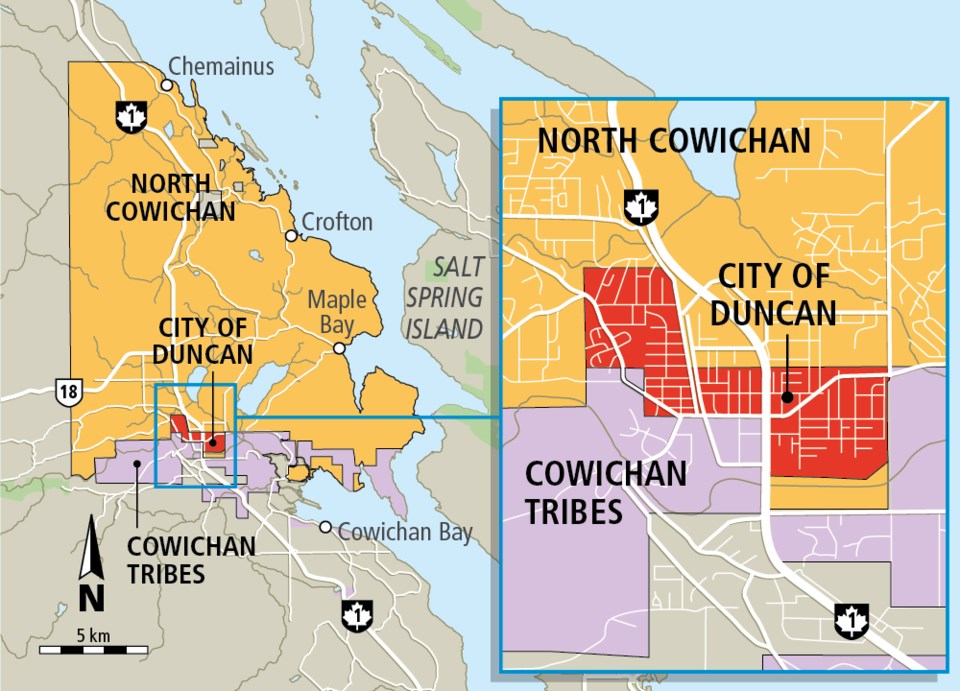• DUNCAN Area: 2.07 square kilometres Population: 4,932
• NORTH COWICHAN Area: 194 square kilometres Population: 28,800
The City of Duncan and the larger, sprawling Municipality of North Cowichan are embarking on studies to consider joining together.
A consultant has been hired to shepherd a citizens assembly, drawn from 5,000 area households, to provide feedback. Letters are expected to go out next month to randomly selected addresses asking for volunteers.
Another consultant is to be hired soon. This one will conduct a review of things like services provided, costs of those services and what might be done jointly.
“It’s worth doing the work before you take a step forward,” said Jon Lefebure, mayor of North Cowichan.
“I don’t think you can say before looking at it more closely whether it will be good or not so good for either party.”
The studies were driven by a referendum question on the last municipal ballot asking if there was interest in the two communities to examine amalgamation.
To the surprise of municipal politicians such as Lefebure, who had seen the issue raised before, majorities in both communities voted yes.
In North Cowichan (population 28,800 in the 2011 census), 68 per cent of the votes cast returned a yes. In Duncan (population 4,932) had 52 per cent vote yes.
The province agreed in September to fund one third of a study up to $47,000.
Duncan was incorporated in 1912 after separating from North Cowichan. It was a move initiated by local businessmen who wanted urban amenities such as sidewalks and water.
The resulting municipality has a small land area, at 2.07 square kilometres. It’s dwarfed by North Cowichan, which is 194 square kilometres and includes two communities, Chemainus (population 3,035) and Crofton (population 1,100).
Duncan and North Cowichan lie within the Cowichan Valley Regional District, which stretches from Shawnigan Lake in the south to Ladysmith and to the end of Nitinat Lake in the west.
Duncan has an odd shape, a kind of lopsided dumbbell, large on the eastern and western ends and narrow in the middle, where it’s less than 500 metres wide.
Over the decades, services have become intertwined.
In some spots, water pipes run side by side going to different customers.
Duncan supplies water to about 15,000 residents, many of whom live in North Cowichan, said Duncan Mayor Phil Kent.
The two municipalities share some costs, such as for recreational centres — the Cowichan Aquatic Centre and the Islands Savings Centre. But neither facility is within Duncan. Both are in North Cowichan, albeit close to the border.
Directly south of Duncan’s south side lies the Cowichan Tribes First Nations community. It has about the same population as Duncan, about 4,800 people. But with 24 square kilometres it’s much bigger and it holds a much longer stretch of the shoreline of the valuable Cowichan River.
There is also intertwining of services there.
Cowichan First Nations buys water from Duncan to supply many of its residents. The sewage treatment plant that serves Cowichan First Nations, Duncan and North Cowichan sits on First Nations land under lease.
It’s difficult to see where one community ends and another begins.
Cross the bridge spanning the Cowichan River heading north and you can see Duncan Mall to your left. But it’s not in Duncan. It’s on Cowichan Tribes land.
By the time you pass the giant hockey stick at Island Savings Centre, you’ve already left Duncan. You are now in North Cowichan, although there has been no obvious sign of that.
For Duncan’s mayor, it’s all a sign of good co-operation. “There has been a lot of co-operation and joint projects which have benefited the area greatly,” Kent said.



